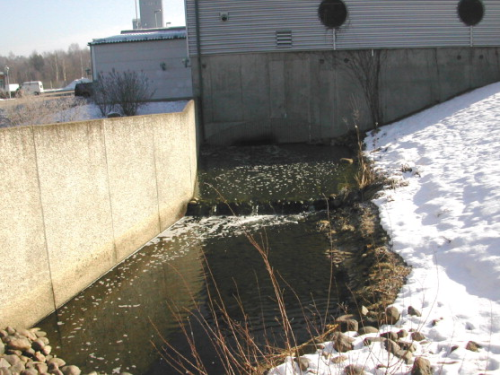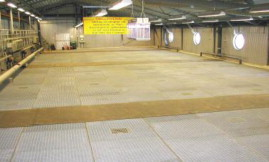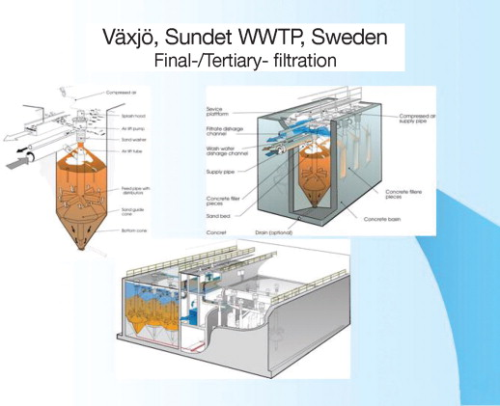


SSAB Svenskt Stål is one of the biggest manufacturers of commercial steel in northern Europe and processes steel at three main locations in Sweden, with heavy plates and slabs manufactured in Oxelösund, steel sheets in Borlänge and slabs in Luleå. The Oxelösund plant, situated 110 km south of Stockholm, is currently the world's leading manufacturer of quenched and tempered wear and structural steels.
Recently, the managers of the Oxelösund plant decided to build a new rolling mill, to replace the original, dating from 1960. While the old mill is 12 m high and weights 1000 tons, its replacement is 17 m high and weighs 2000 tons. The new mill, which cost SEK 1650 million, was designed to improve product quality and offer new opportunities for process and product development. Along with the installation of the new rolling mill, the company decided to install a new water filtration plant at the same time.
Plant requirements
“We had two main motivations. First and foremost was our environmental policy: with the establishment of our new mill, we introduced the principle of 100% recycling,” explained Jan-Erik Bengtsson, project leader of the water treatment plant. “This means that our goal is to recycle all the cooling water used and all the slag produced by the cooling process. Consequently, following cooling we have to separate the slag from the water, clean the water for reuse and return the slag to the blast furnace, where it is an excellent raw material.
“Our second motivation was of a purely technical nature,” he added. “The cooling water we use needs to be of a very high standard of purity.” During the last stage of the plant's steel plate production process, called the direct cooling stage, engineers use an advanced cooling system which requires very clean water. The equipment consists of 37,000 nozzles, with a diameter of approximately 4 mm and about 100 mm in length. Water is discharged through these nozzles under very low pressure – more or less just gravity. “The nozzles can easily become blocked, especially because the water passing through them is under very low pressure,” said Bengtsson.
According to him, the minimum requirements for water quality for this process are less than 10 mg of suspended solids per litre and under 2 mg per litre content of oil or grease. (Oil and grease tend to leak into the cooling water from the rolling mills' lubrication systems.) The plant's direct cooling stages requires up to 15,000 m3 of water per hour and, as far as Bengtsson knows, it's the only one (or one of very few) currently in operation in Europe.
Principles of Dynasand
The DynaSand plant at SSAB Oxelösund was constructed as a turnkey project by Nordic Water Products (which is part of the Waterlink Group). It currently consists of 20 DynaSand units, although it is designed to accommodate up to 30 units, should future expansion be required. All of the units are in continuous operation 24 hours a day. Precipitation is brought about inside the DynaSand units by adding a chemical coagulant, polyaluminium chloride, which forms flocs from the oil and finer particles. The coagulant is added at the inlet to the DynaSand units and then the flocs are filtered out by the DynaSand's sandbed.
One advantage of the DynaSand filter is its elimination of backwashing, which has conventionally reduced the efficiency of sand filters. With the DynaSand filter, fouled sand is continuously removed from the filter bed, washed, and recycled without interruption to the filtration process.
This filter is based on the counterflow principle, by which the water to be treated is admitted through the inlet distributor in the lower section of the unit and is cleaned as it flows upward through the sand bed, prior to discharge through the filtrate outlet at the top. The sand containing the entrapped impurities is conveyed from the tapered bottom section of the unit, by means of an air-lift pump, to the sand washer at the top. Cleaning of the sand commences in the pump itself, in which particles of dirt are separated from the sand grains by the turbulent mixing action. The contaminated sand spills from the pump outlet into the washer labyrinth where it is washed by a small flow of clean water. The impurities are discharged through the wash water outlet while the grains of clean sand (which are heavier) are retained to the sand bed. As a result, the bed is in constant downward motion through the unit and water purification and sand washing both take place continuously, enabling the filter to remain in service without interruption.
The recycling process
The Oxelösund plant's recycling process operates by collecting both the cooling water and the slag formed on the surface of steel by the roller cooling in a basin under the rolling mill. This basin empties by gravity to a large sump, which receives about 1,000 m3 per hour of the slurry formed by the cooling water and slag particles. Slag recovery is achieved in three stages.
For the first stage, a crane with a bucket jaw mechanism is positioned above the sump. Periodically it is lowered into the sump to extract the large pieces of slurry. The crane deposits these in a container, which is removed and eventually emptied into the raw material feed for the blast furnace.
In the second stage, the finer slurry is pumped up to two sedimentation basins where the slurry is sedimented out. The slag which settles out here is removed and returned to the blast furnace, while the water from the sedimentation basins, containing the finest slag particles, goes into the DynaSand plant. Having been filtered out of the water, these finer slag particles, together with the oil and grease removed by the DynaSand filters, are compressed into a brick-like form and returned to the blast furnace. Prior to the installation of the DynaSand plant, these finer slag particles would have been simply discharged in the plant's wastewater.
In the third stage, the cleaned water from the DynaSand plant is channelled into two large underground rock-cavern storage facilities, which have a total capacity to store 57,000 m3 of water. All the process water for the plant is drawn from these storage caverns, while the raw water for the plant, which can contain up to 14 mg of suspended solids per litre, is taken from the nearby Nyköping river. Besides the 15,000 m3/hr required by the plant's direct cooling system, between 600 to 800 m3/hr of process water is required by the rolling mills themselves and all these flows have to be maintained 24 hours a day.
Of the water which passes through the DynaSand filter plant about 80% goes directly back into the plant's water recycling system, and the remaining 20% is diverted into longer term storage. Therefore, although the principle of more or less 100% recycling of the cooling water is maintained, the plant has other process water systems which do discharge water, and the plant still has a significant intake from and discharge to the river.
“By implementing our new philosophy of water recycling we've been able to reduce our exchange of water with the river despite building a second rolling mill in the plant – which has obviously significantly increased our consumption of process water,” said Bengtsson. “[Moreover], the quality of the water which we're discharging from the plant is now actually higher than the quality of the water which we're taking in from the river. The DynaSand filters have certainly helped us to achieve these results.”
As well as this, the suspended solid content of the filtered water is down to around 5 mg per litre and the oil and grease content is also significantly reduced. There are no clogging problems in the thousands of nozzles used in the low-pressure cooling system.






